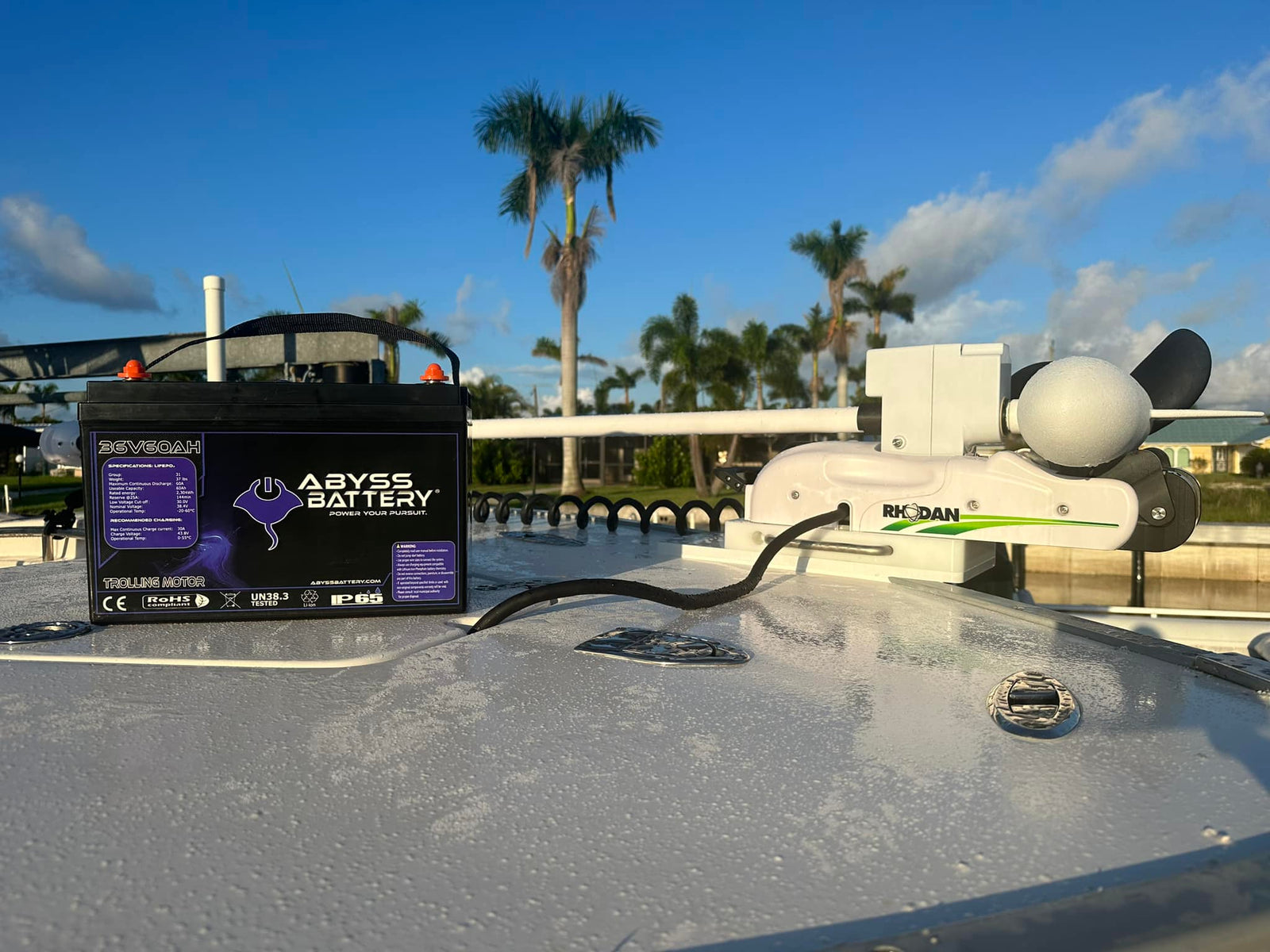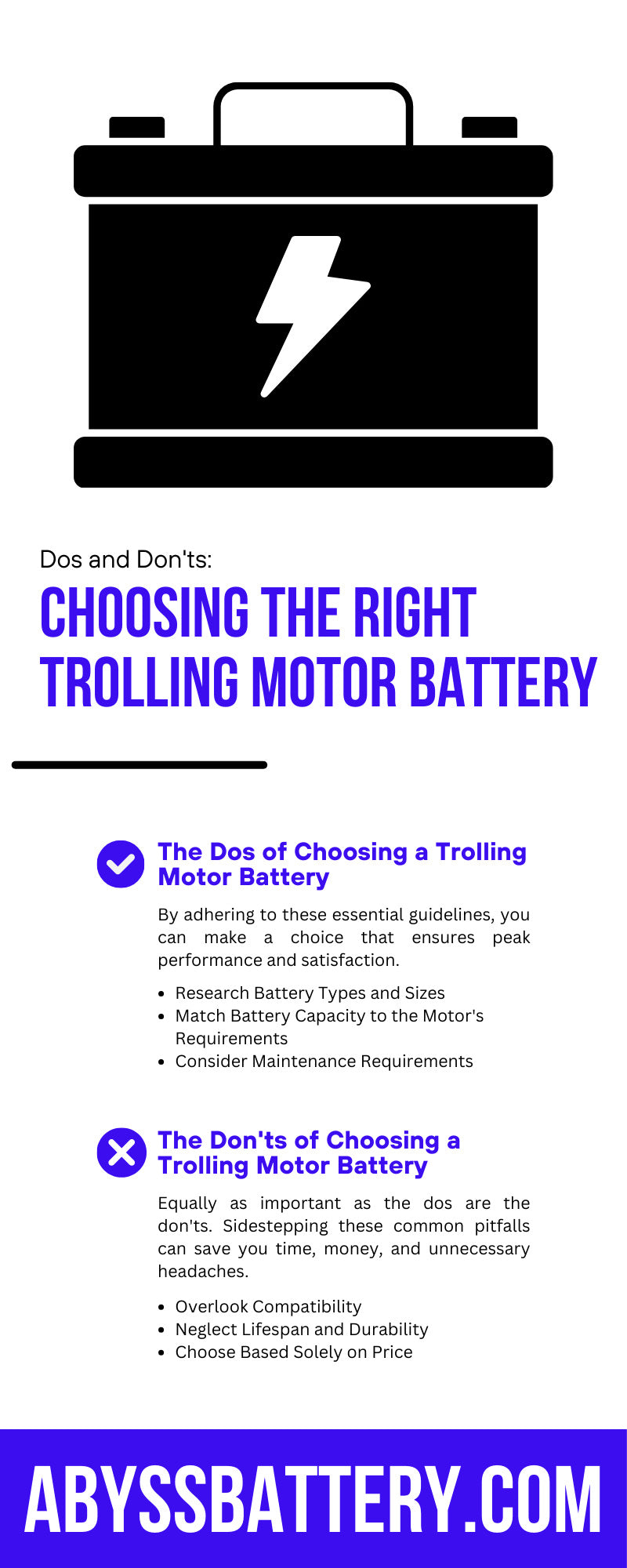Dos and Don'ts: Choosing the Right Trolling Motor Battery

Your trolling motor is the heart of your boating experience, the silent force that propels you through the waters, positioning you perfectly for that elusive catch. Unfortunately, without the right battery, your day can quickly go from tranquility to frustration.
As a boat enthusiast or angler, the quality of your battery is essential to your experience. In this comprehensive guide, we'll explore the dos and don'ts of choosing the right trolling motor battery so that you can enjoy smooth sailing with confidence.
Understanding Trolling Motor Batteries
Before we power into battery selection, it's crucial to understand what's available. Trolling motor batteries come in various types and capacities, each offering unique advantages and challenges.
Battery Types
The most common trolling motor batteries are lead-acid and lithium-ion. Lead-acid batteries are affordable and reliable, making them a popular choice among boaters. However, they're relatively heavy and require regular maintenance. On the other hand, lithium-ion batteries are lighter, smaller, and virtually maintenance-free, making them an excellent option for those who prioritize convenience.
Factors To Consider
When selecting a trolling motor battery, several factors play a role in determining the right fit for your needs:
- Capacity: Battery capacity, measured in amp-hours (Ah), signifies how long the battery can deliver a specific amount of current before needing recharging. A higher capacity means longer runtime for your motor, allowing you to stay out on the water for extended periods without worry.
- Voltage: Trolling motors usually operate on 12, 24, or 36 volts. Selecting the right voltage is critical, as it directly impacts the motor's thrust, speed, and efficiency. A 24-volt marine battery, for instance, will offer more capacity than a 12-volt but less than a 36-volt battery. Ensure the battery's voltage matches the motor's requirements to avoid underperformance or damage.
- Weight: The weight of the battery is an often overlooked consideration. A lighter battery will not only make transportation and installation easier but will also contribute to better boat balance and overall handling.
Carefully considering these factors before your purchase will ensure your cell can handle your needs and won't run out of energy in the middle of a trip.
Now that you've got a clear idea of the different types of batteries and key characteristics to look for, it's time to explore some best practices to follow during the selection process.
The Dos of Choosing a Trolling Motor Battery
Selecting the right trolling motor battery doesn't have to be a shot in the dark. By adhering to these essential guidelines, you can make a choice that ensures peak performance and satisfaction.
Research Battery Types and Sizes
Before making a purchase, invest time in researching the range of battery types and sizes available. Understand the pros and cons of each type, as well as how they align with your motor's specifications and your usage patterns. Battery types differ primarily in their chemistry, which affects performance, longevity, and upkeep. By evaluating why each battery type or size suits certain conditions, boaters can better match their specific needs with a battery that offers optimal compatibility and reliability.
Match Battery Capacity to the Motor's Requirements
The golden rule is to match the battery capacity to your trolling motor's power requirements. This guarantees that you'll have the right amount of power and prevents overtaxing the battery, which can lead to premature failure. Select a battery that aligns not just with your boat's needs but also with your lifestyle, ensuring the power source doesn't turn into an unforeseen burden or expense due to mismatched usage expectations.
Consider Maintenance Requirements
You should never overlook maintenance when selecting a trolling motor battery, as it directly impacts performance and longevity. However, different batteries demand different levels of care. Lead-acid batteries require periodic checks and maintenance, such as topping up with distilled water, whereas lithium-ion batteries are virtually maintenance-free. Choose a battery that aligns with the level of care you're willing to provide.
The Don'ts of Choosing a Trolling Motor Battery
Equally as important as the dos are the don'ts. Sidestepping these common pitfalls can save you time, money, and unnecessary headaches.
Overlook Compatibility
Ignoring compatibility can lead to ineffective operation and even damage your trolling motor. Incompatible batteries may not deliver the correct current or voltage, leading to suboptimal performance or overheating. Furthermore, using the wrong type of battery might void your warranty or worse. That's why it's critical to ensure the battery fits within your boat's power system and works with the features and requirements of your trolling motor.
Neglect Lifespan and Durability
Every battery comes with an estimated life expectancy, which is affected by its build quality, usage conditions, and maintenance routines. A durable, higher-quality battery may cost more upfront but will serve you better over time, reducing the frequency of replacements and ensuring consistent performance. Choosing a battery is especially pertinent for those who rely heavily on their trolling motor for regular trips or long outings where a reliable power supply is paramount.
Choose Based Solely on Price
While it's tempting to go for the cheapest option, a trolling motor battery should be considered an investment. Initial savings might be appealing but quickly diminish if the battery underperforms or requires early replacement. Investing in a more robust and efficient battery may reduce the frequency of replacements, thus saving money and hassle over time. Opting for quality over the lowest price will result in a more satisfying and cost-effective boating experience.
Best Practices for Battery Maintenance
Proper maintenance is the key to longevity and performance when it comes to trolling motor batteries. Following these best practices will ensure your battery is always ready to support your outdoor adventures.
Extending Battery Life
Simple tasks such as regularly charging your battery, avoiding over-discharge, and using the correct charging equipment can significantly prolong its life. Additionally, ensuring the battery's terminals are clean and the connections are secure will prevent power loss and potential damage.
Storage and Charging Recommendations
Store your battery in a cool, dry place away from direct sunlight when not in use. As for charging, adhere to the manufacturer's recommendations for optimal charging cycles and durations. Overcharging or undercharging can be detrimental to your battery's health.
Enjoy the Tranquility of the Open Waters
The battery you choose for your trolling motor is more than just a power source—it's the cornerstone of your on-water lifestyle. By understanding the nuances of choosing trolling motor batteries and following the dos and don’ts outlined above, you can make an informed decision and ensure your day goes off without a hitch. Remember to prioritize compatibility, quality, and proper maintenance, and you'll be well on your way to enjoying the tranquility of the open waters.



Leave a comment